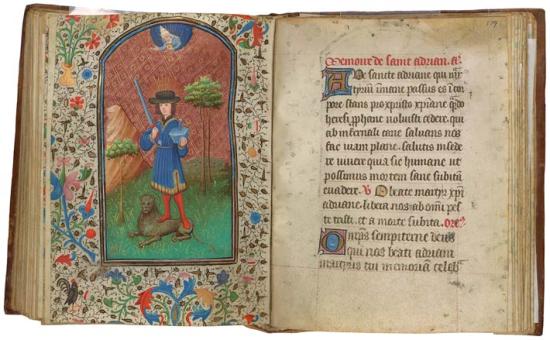
Book of Hours, in Latin and French
Illuminated by a Master of the Gold Scrolls
Gift of Julia Parker Wightman, 1993
That artists kept the clothing they depicted in their illuminations current is confirmed by comparing this Adrian with the one exhibited in Section 3. Here the saint is also well-attired, albeit in styles from around 1440. He wears a fur-lined, knee-length gown that is belted at the waist. The regular pleating and the slightly opened V neck, above which juts the collar of his doublet, are new features of the tailoring. Also new is his fur hat with its round crown and wide brim. Adrian's attributes include the anvil and hammer that were used to break his bones.
Peacocks of the Midcentury
In 1435, during the final chapter of the Hundred Years' War, Duke Philip the Good switched sides and supported King Charles VII. By the following year, the English occupation of Paris ended. When Charles VII regained Normandy and Aquitaine in 1453, the long war was finally over. In the ensuing period of peace and prosperity, fashion revived.
These decades saw the last of the houpeland. It continued to be worn by men and women in provincial areas, but in France and Flanders it was appropriate only for formal occasions. Men more often wore the gown: full or knee length, belted at the waist. Over the course of these thirty years, men's gowns, via flaring pleats and ample shoulder padding, assumed a flattering, V-shaped silhouette. While the chaperon remained popular, new hats also arrived.
Women's gowns featured wide V necks with contrasting collars and partlets (plackards worn at the midriff). Headgear atop the temples continued to evolve, growing ever more extravagant. Burlets got thicker and climbed higher. Butterfly veils, supported by wires, floated like sails above ladies' heads.
